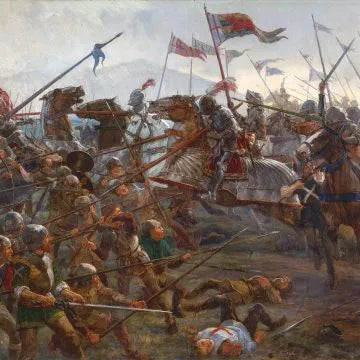

English School
The Battle of Flodden
Oil on canvas, monogrammed and dated 1910 lower right
Image size: 25 x 50 inches (63.5 x 127 cm)
Original frame
The Battle of Flodden or Flodden Field, sometimes called the Battle of Branxton, was part of a conflict between England and Scotland. The Scots were allied with France and at the time of the battle Henry VIII was fighting in France and had left his kingdom under the regency of his queen, Catherine of Aragon.
The battle was fought in Branxton in Northumberland on 9 September 1513, between an invading Scots army under King James IV and an English army commanded by the seasoned warrior Thomas Howard, Earl of Surrey. Invoking the Auld Alliance with France, James IV of Scotland crossed the Tweed with a large well-equipped army. He took Norham, Etal and Ford Castles and established a stronghold a mile to the south of there, on Flodden Hill.
Surrey marched his forces north but avoided the Scottish position with a wide flanking move to the east, making his approach to the Battle from the north, via Twizel Bridge. James was forced to relinquish his fortifications and move his troops and heavy cannon to the ridge of Branxton Hill. The English lines spread out west to east along the ridge on which Branxton stands.
Battle commenced in the late afternoon of 9th September 1513, when the Scots’ guns opened fire. It was dull, damp and muddy, having rained for most of the day. In the following hours, these fields became the scene of bloody carnage in which an estimated 4,000 Englishmen and 10,000 Scottish lost their lives.
The English won a resounding victory. King James IV was killed in the battle and his body is reputed to have been sent in a coffin to Catherine, who in turn sent the Scottish king’s coat to Henry VIII in France, to use as a banner in the war there.
In the painting we can see various heraldic banners, such as the ones listed below:
The banner showing a red field with the white lion marked with a blue crescent represents Thomas Howard, 2nd Duke of Norfolk (or possibly Edmund Howard, future 3rd Duke of Norfolk)
The gold and green field, with the gold falcon eating a baby represents Edward Stanley, 1st Baron Monteagle KG
The gold and blue field, with a red bull represents Thomas Dacre, 2nd Baron Dacre of Gilsland, KG.



